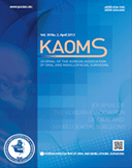Journal of the Korean Association of Oral and Maxillofacial Surgeons
- P-ISSN2234-7550
- E-ISSN2234-5930
- SCOPUS, KCI, ESCI
 ISSN : 2234-7550
ISSN : 2234-7550
Prevalence, pattern, etiology, and management of maxillofacial trauma in a developing country: a retrospective study
Sree Vijayabala G (ESIC Medical College)
Rajesh Kumar Udhayakumar (ESIC Medical College)
Abstract
Objectives: This retrospective study aims to evaluate the prevalence of maxillofacial trauma in a developing country, along with its pattern, etiology and management. Data for the present study were collected from the Department of Dentistry, ESIC Medical College and Post Graduate Institute of Medical Sciences and Research, Chennai in India.Materials and Methods: The medical records of patients treated for maxillofacial injuries between May 2014 and November 2015 were retrospec-tively retrieved and analyzed for prevalence, pattern, etiology, and management of maxillofacial trauma. SPSS software version 16.0 was used for the data analysis.Results: Maxillofacial fractures accounts for 93.3% of total injuries. The mean and standard deviation for the age of the patients were 35.0±11.8 years and with a minimum age of 5 years and maximum age of 75 years. Adults from 20 to 40 years age groups were more commonly involved, with a male to female ratio of 3:1. There was a statistically significantly higher proportion of males more commonly involved in accident and injuries (P <0.001). Conclusion: The most common etiology of maxillofacial injury was road traffic accidents (RTA) followed by falls and assaults, the sports injuries seem to be very less. In RTA, motorized two-wheelers (MTW) were the most common cause of incidents. The majority of victims of RTA were young adult males between the ages of 20 to 40 years. The malar bone and maxilla were the most common sites of fracture, followed by the mandible. The right side of the zygomatic complex was the predominant side of MTW injury. The majority of the zygomatic complex fractures were treated by con-servative management. Open reduction and internal fixation were performed for indicated fracture patients.
- keywords
- Fractures, Injuries, Mandible, Maxillofacial, Zygomatic
- 다운로드 수
- 조회수
- 0KCI 피인용수
- 0WOS 피인용수